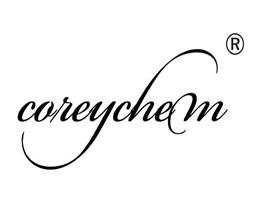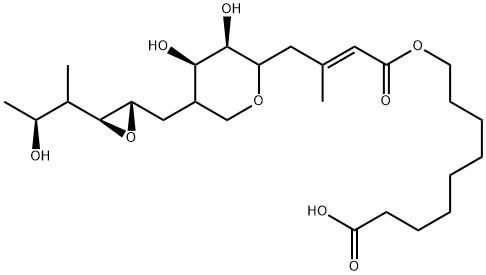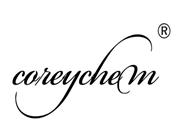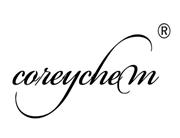| Topical antibiotics |
The crude drug of Bactroban ointment produced by the well-known domestic pharmaceutical company SmithKline is mupirocin which is a new type of local topical antibiotic and a kind of metabolic substance produced in the culture solution of pseudomonas fluorescence, that is, Pseudomonas A. Mainly through reversibly combined with isoleucine transfer RNA synthetase, this product can prevent the isoleucine incorporation and terminate the protein synthesis in cells containing isoleucine, leading to bacterial death. At low concentrations, this product has the inhibitory effect and at high concentrations, it has the bactericidal effect. This product is highly sensitive to a variety of gram-positive bacteria associated with skin infections, particularly staphylococcus aureus (including drug-resistant staphylococcus aureus) and streptococcus pyogenes; and it is also available for listeria monocytogenes and erythema erysipelothrix bacteria; it is generally not sensitive to gram-negative bacteria, but have some antibacterial effect on some Gram-negative bacteria such as E. coli, neisseria, haemophilus influenzae and Neisseria gonorrhoeae and is not sensitive to the majority of anaerobic bacteria and the normal flora of the skin and has low efficacy against fungi. Rate of occurrence is very low in vitro resistant mutants. After applied into the skin, this medicine can penetrate into the stratum corneum, but the absorption rate is very low. The binding rate of this drug and human serum protein is 95%. when absorbed, it is rapidly metabolized to an inactive substance single spore acid (Monic Acid) and excreted by the kidneys. The minimum inhibitory concentration of most sensitive staphylococcus is 0.01~0.25mg/L, that of sensitive streptococcus is 0.06~0.5mg/L, and that of listeriosis is 8mg/L. This product is more effective in vitro tests under acidic conditions than that under alkaline conditions. When human serum exists, activity of this drug reduce to 1/10~1/20.
Currently, in China, mupirocin is mainly and clinically used for the treatment of staphylococcus aureus and streptococcus caused by various infectious skin diseases: primary skin infections such as impetigo, folliculitis, and boils carbuncles etc; secondary skin infections such as eczema, atopic dermatitis, skin ulcers, surgical wounds, small burns, skin trauma; and other prevent infections such as small wounds, wound infections, and other sterilization venereal damage. |
| Side effects |
Topical application of this drug is generally no adverse reactions, occasionally with skin burning sensation, stinging sensation, aminotransferase rising, itching, dryness and erythema. Its occurrence rate is very low(3%) with a lesser degree. The medicine is generally tolerated and without being stopped. For long-term use, this drug may result in overgrowth of non-susceptible strains; nasal agent can cause headache, taste disturbance, rhinitis, pharyngitis, and other respiratory disorders.
The above information is edited by the Chemiclbook of Bai Linlin. |
| Precautions |
1. Allergies of pseudomonas acid or polyethylene glycol are disabled to use; patients who suffer from moderate or severe renal impairment use it with caution; the impact on pregnant or lactating women are not clear, temporarily not available.
2. Ointments made from polyethylene glycol which is used as a substrate, is only available for a small area of skin bacterial infection, and cannot be used to extensive burns or wounds so as to prevent the renal damage due to the absorption of polyethylene glycol, as well as mucous membranes, for example, used in the eyes and noses. As with nasal staph infections, the use of ointment base should be replaced by vaseline.
3. Although mupirocin toxicity is low, we should avoid the abuse or the use of the drug for a long term in case of generating drug-resistant strains. |
| Chemical Properties |
This medicine can be obtained from crystallized ether, and its melting point is 77~78 ℃. [α]D20-19.3°(C = 1, methanol). The maximum absorption of UV (ethanol): 222nm(ε14500). |
| Uses |
Topical antibiotics. This product is generally used for the inflammation of the skin, eczema, etc., or made into mupirocin ointment in the market.By reversibly binding to isoleucine transfer RNA synthetase, this product can prevent isoleucine incorporated so that the synthesis of all proteins in cells containing isoleucine can be stopped. |
| Production Methods |
It is a kind of substance produced by the pseudomonas fluorescence, including pseudomonic acids A, B, C, D. Mupirocin is pseudomonic acid A which is the major metabolite. |
| Chemical Properties |
White Crystalline Solid |
| Uses |
antibacterial, antimycoplasmal, isoleucyl-tRNA synthetase inhibitor |
| Uses |
Mupirocin, is a major component of the pseudomonic acid, an antibiotic complex produced by Pseudomonas fluorescens NCIB 10586. Topical antibacterial. |
| Uses |
Pseudomonic acid is a potent antibiotic produced by Pseudomonas fluorescens, reported by Fuller et al. in 1971. Pseudomonic acid has broad spectrum activity against Gram positive bacteria and was approved for topical human use in 1985. Pseudomonic acid acts as a potent and selective inhibitor of isoleucyl-tRNA synthetase. |
| Uses |
vasodilator |
| Uses |
An antibiotic inhibitor of isoleucyl-tRNA synthetase |
| Definition |
ChEBI: An alpha,beta-unsaturated ester resulting from the formal condensation of the alcoholic hydroxy group of 9-hydroxynonanoic acid with the carboxy group of (2E)-4-[(2S)-tetrahydro-2 -pyran-2-yl]-3-methylbut-2-enoic acid in which the tetrahydropyranyl ring is substituted at positions 3 and 4 by hydroxy groups and at position 5 by a {(2S,3S)-3-[(2S,3S)-3-hydro ybutan-2-yl]oxiran-2-yl}methyl group. Originally isolated from the Gram-negative bacterium Pseudomonas fluorescens, it is used as a topical antibiotic for the treatment of Gram-positive bacterial infections. |

 China
China







